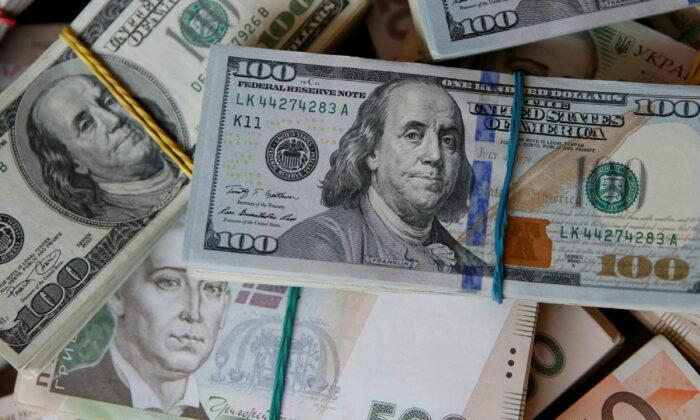LONDON/TOKYO—The dollar was little changed on Friday after jumping in the previous session, as traders analyzed a raft of central bank rate hikes and grappled with the prospect that borrowing costs still have a way to climb.
The euro was flat against the dollar in early European trading at $1.063. That followed a 0.5 percent fall on Thursday after the European Central Bank (ECB) raised interest rates and signaled it was far from finished, raising fears about the potential damage to the global economy and sending investors towards the safe-haven greenback.
A day earlier, Federal Reserve Chair Jerome Powell said policymakers expected U.S. rates to rise further and stay elevated for longer. The “hawkish” rhetoric of central banks has caused traders to reconsider their bets that the pain from rising interest rates might soon be over, triggering a sell-off in global stocks and European bonds on Thursday and Friday.
“Yesterday was a big ‘risk-off’, so typically the dollar stands to benefit as a safe-haven asset,” said Alvin Tan, head of Asia FX strategy at RBC Capital Markets.
“In the short term we have a situation in which the market wants to sell dollars, not withstanding yesterday’s price action, but as we get into the new year we think that could reverse on account of the global growth slowdown.”
Against Japan’s yen, the greenback was down 0.54 percent on Friday to 137.01. Yet it was up 0.43 percent against sterling, with pounds changing hands at $1.213.
The dollar index, which gauges the currency against six major peers, was roughly flat at 104.53, after rallying more than 0.9 percent on Thursday.
The index has surged around 9 percent this year as the Fed has hiked interest rates hard, sucking money back towards dollar-denominated bonds. Yet it has dropped roughly 8 percent since hitting a 20-year high in September, as a slowdown in U.S. inflation has raised hopes the Fed’s rate-hiking cycle might soon end.
The dollar-yen pair was among the most volatile on Friday. The Bank of Japan (BOJ) decides policy on Tuesday, and while no change is expected at that meeting, some market participants have begun betting on some tweaks to stimulus as Governor Haruhiko Kuroda prepares to depart in April.
“I am with the market consensus and don’t expect any policy change at the BOJ’s December meeting, but I want to carefully watch for any comments from Governor Kuroda about the next leadership,” said Takahiro Sekido, chief Japan strategist at MUFG.
“Market participants may take that as a signal for policy normalisation, and that may support a strong yen,” added Sekido, who says the dollar may weaken to 125 yen over 2023.
The risk-sensitive Australian dollar was 0.11 percent lower at $0.669. It slid 2.38 percent in the previous session—its biggest drop since March 2020.
The New Zealand dollar rose 0.17 percent to $0.635.





